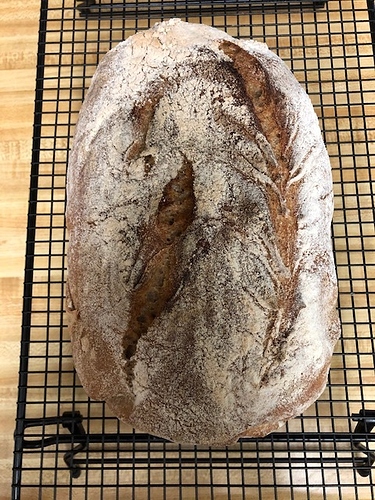Hi everyone! I did bake the revised no-knead sourdough bread recipe today. My experience with the newer technique was definitely interesting.
I followed the measurements by weight exactly as written in the recipe. I used Breadtopia’s high-protein organic bread four for the white bread flour component and a mixture of Breadtopia’s Red Fife and Heirloom Turkey Red whole wheat berries that I milled in my Mockmill 100 for the whole wheat portion. The flour component was indeed 50/50 bread flour/whole wheat.
I do reduce the amount of salt to one-third the amount in the recipe for every bread I bake for health reasons. I find that particular amount of salt is enough to amp the flavor to where it needs to be while at the same time keeping the bread lower sodium. On a side-note, I’ve not noticed a change in the flavor of a finished loaf of bread when using the reduced amount of salt as compared to the amount of salt written into the recipe. So for me, it’s a win-win. I can still bake a tasty loaf of bread while maintaining a lower sodium requirement.
For me as far as the newer technique goes, let’s just say the jury’s still out. Wetting my hands to engage in the stretch and fold of the dough made my particular dough too wet. After doing the stretch and fold it did not resemble Eric’s dough in the video. It was more of a wet, shaggy mess. Perhaps if I had used the “stretch and fold” technique with the dough whisk as in the rye bread video my dough would have looked more like Eric’s as it wouldn’t have gotten wetter. I may consider that if I try this recipe again.
After an overnight rise on the kitchen counter for about 8 hours (my kitchen’s ambient temperature hovers around 78-80 degrees currently) the dough was ready for me to release from the bowl and attempt a coil fold. Let’s just say that was rather comical. The dough kinda-sorta cooperated but was significantly wetter than the dough in Eric’s video. Turning the dough over in my hands to put it into the lined proofing basket was almost an exercise in futility as it oozed through my fingers seemingly embracing a life of its own. Forget about pinching a seam. I swear the dough was laughing at me.
I covered the basket in plastic and let it rise about 45 minutes. It rose but was still loose and wet. Thankfully I use a parchment paper technique to transfer my dough from the basket to the preheated clay baker. Otherwise I think the dough would have just oozed out of the basket onto the floor. The dough plopped into the clay baker deflating it a bit. I tried scoring the top but the dough was so wet it wouldn’t score.
I baked it at 500 degrees for 17 minutes covered and then another 17 minutes uncovered.
I did get a bit of an oven spring but wish it had been more. The bread temperature reached 205 degrees so I knew it was sufficiently baked.
The slices and crumb are nice albeit on the moister side. With the flour being a 50/50 mix the flavor is definitely a heavier whole wheat versus the original recipe that had approximately 30% whole wheat to 70% white bread flour. The flavor and texture of this newer recipe is good IF you’re a fan of a more whole wheat sourdough. Since my husband, my sweet Stanley, is not as much of an aficionado of whole wheat as I am, I may revert back to the original recipe more routinely. I do find the technique of the original recipe and the dough’s behavior easier for me to deal with and my husband seems to enjoy the “lighter tasting” resulting loaf of the original recipe.
Will I bake this recipe again? Perhaps when I’m feeling ambitious. But when I need to whip up a “plain” sourdough bread, I will probably stick to my “tried and true” original Breadtopia NK sourdough recipe I first learned from and have always had success with.
Keep baking!
Leah




 I need to try my epic fail again someday, with a few modifications.
I need to try my epic fail again someday, with a few modifications.